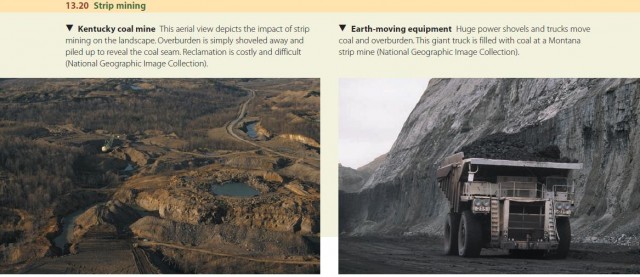Mass Wasting
So far, we've looked at a selection of processes that alter rock chemically or break them into fragments. But what happens to these pieces once they've been loosened from the parent rock? The rock fragments are subjected to gravity, running water, waves, wind, and the flow of glacial ice. In this chapter we'll concentrate on the effect of gravity, and we'll return to the other effects in the following chapters.
Gravity pulls down continuously on all materials across the Earth's surface. Unweathered rock is usually so strong and well supported that it remains fixed in place. But when a mountain slope becomes too steep, rock masses can break free and fall or slide into valleys below. In cases where huge masses of bedrock are involved, towns and villages in the path of the slide can be catastrophically damaged.
These events are one form of mass wasting—the spontaneous downhill movement of soil, regolith, and rock caused by gravity.
Because soil, regolith, and many forms of sediment are poorly held together, they are much easier to move than hard, unweathered bedrock. On most slopes, at least a small amount of downhill movement is going on constantly. The processes of mass wasting and the landforms they produce are quite varied and tend to grade one into another. Figure 13.10 shows the forms of mass wasting that we will describe in this chapter, sorted by the material that is moving, the amount of water involved, and the speed of the movement.
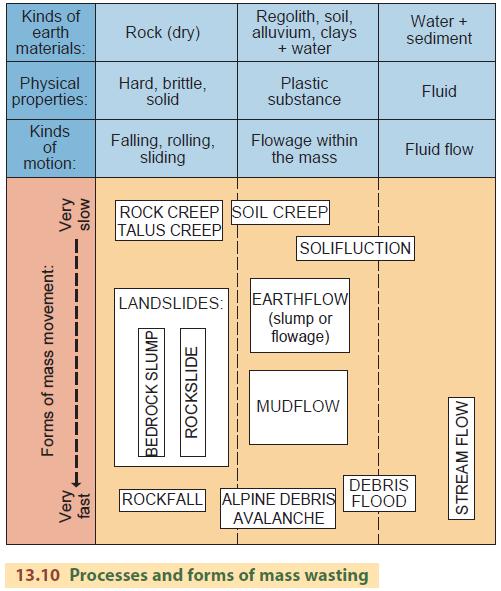
SLOPES
Mass wasting happens on slopes—patches of the land surface that are inclined from the horizontal. Slopes guide the flow of surface water downhill and fit together to form stream channels. Nearly all natural surfaces slope to some degree.
Most slopes are covered with regolith, which grades downward into solid, unaltered rock, known simply as bedrock. Sediment consists of rock or mineral particles that are transported and deposited by fluids, which can be water, air, or even glacial ice. Regolith and sediment are the parent materials of soil. Figure 13.11 shows a typical hillslope that forms one wall of the valley of a small stream. Water and gravity transport regolith downhill to form colluvium. Streamflow transports sediment along the stream valley and deposits the sediment as alluvium.
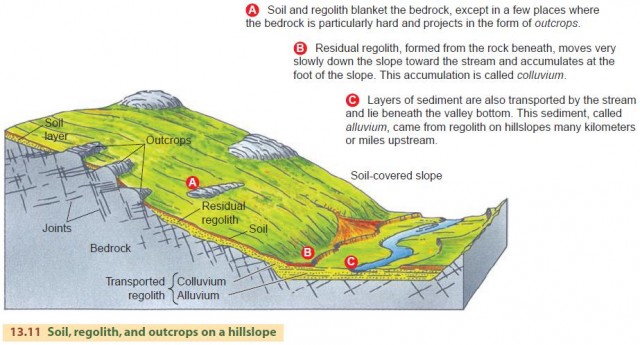
On almost every soil-covered slope, soil and regolith will slowly move downhill. This is called soil creep. The process is triggered when soil and regolith are disturbed by alternate drying and wetting, growth of ice needles and lenses, heating and cooling, trampling and burrowing by animals, and shaking by earthquakes. Gravity pulls on every such rearrangement, and the particles very gradually work their way downslope. In some layered rocks such as shales or slates, edges of the strata seem to “bend” in the downhill direction.
EARTHFLOW
In humid climates, water-saturated soil, regolith, or weak shale can move down a steep slope in just a few hours. This is an earthflow. It's common to see shallow earthflows, affecting only the soil and regolith, on sod-covered and forested slopes that have been saturated by heavy rains. An earthflow can affect a few square meters, or it may cover an area of a few hectares (several acres). If the bedrock of a mountainous region is rich in clay, earthflows can involve millions of metric tons of bedrock moving like a great mass of thick mud.
During heavy rains, earthflows can block highways and railroad lines. The flows aren't usually a threat to life because they move slowly, but they can often severely damage buildings, pavements, and utility lines that have been constructed on unstable slopes.
MUDFLOW AND DEBRIS FLOOD
One of the most spectacular forms of mass wasting and a potentially serious environmental hazard is the mudflow. This mud stream pours swiftly down canyons in mountainous regions (Figure 13.14). In deserts, thunderstorms produce rain much faster than it can be absorbed by the soil. Without vegetation to protect soil slopes, the excess water runs off, picking up fine particles to form a thin mud that flows down to the canyon floors and then follows the stream courses. As it flows, it picks up additional sediment, becoming thicker and thicker until it is too thick to flow farther. Great boulders are carried along, buoyed up in the mud. Roads, bridges, and houses in the canyon floor are engulfed and destroyed. The mudflow can severely damage property and even cause death as it emerges from the canyon and spreads out.
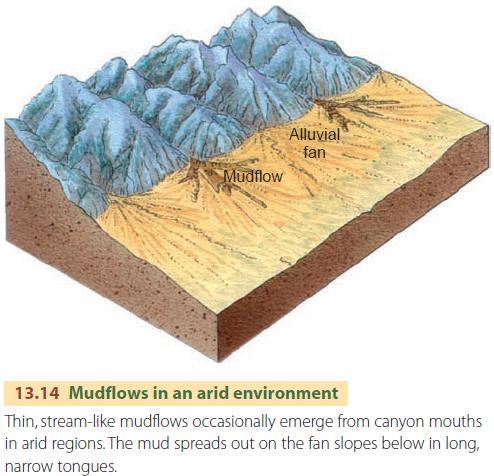
Mudflows on the slopes of erupting volcanoes are called lahars. Heavy rains or melting snow turn freshly fallen volcanic ash and dust into mud that flows downhill. Herculaneum, a city at the base of Mount Vesuvius, was destroyed by a mudflow during the eruption of a.d 79. At the same time, the neighboring city of Pompeii was buried under volcanic ash.
Mudflows vary in consistency. They range from the thickness of concrete emerging from a mixing truck to more watery consistencies, similar to the floodwaters of a turbid river. The watery type of mudflow is called a debris flood or debris flow in the western United States. Debris flows are common in Southern California, with disastrous effects. They can carry anything from fine particles and boulders to tree trunks and limbs.
On steep slopes in mountainous regions, these flows are called alpine debris avalanches. The intense rainfall of hurricanes striking the southeastern United States will often cause debris avalanches in the hollows and valleys of the Blue Ridge and Smoky Mountains.
LANDSLIDE
A large mass of bedrock or regolith sliding downhill is known as a landslide. Large, disastrous landslides are possible wherever mountain slopes are steep (Figure 13.17). In Switzerland, Norway, or the Canadian Rockies, for example, villages built on the floors of steep-sided valleys have been destroyed when millions of cubic meters of rock descended without warning. This chapter's opening section described a landslide in a similar environment and its consequences.
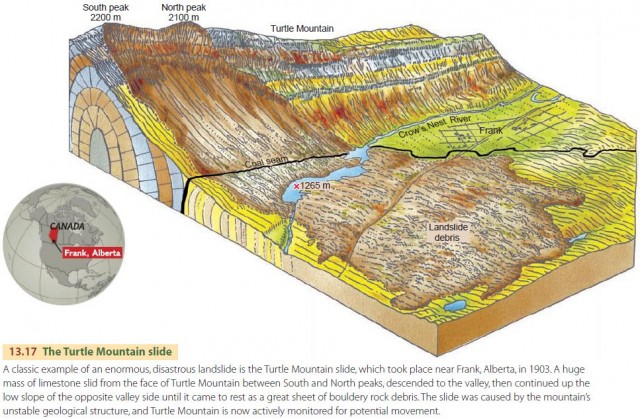
Unlike mudflows and earthflows, which are triggered by heavy rain, landslides are set off by sudden rock failures or earthquakes. Landslides can also result when the base of a slope is made too steep by excavation or river erosion. Landslides range from rockslides of jumbled bedrock fragments to bedrock slumps in which most of the bedrock remains more or less intact as it moves. In a rockslide, rubble travels down a mountainside at amazing speed. Geologists think this speed is possible because there is a layer of compressed air trapped between the slide and the ground surface. This air layer reduces friction, so the rubble can move faster.
INDUCED MASS WASTING
Human activities can induce mass wasting processes by creating unstable piles of waste soil and rock and by removing the underlying support of natural masses of soil, regolith, and bedrock. Mass movements produced by human activities are called induced mass wasting.
In Los Angeles County, California, roads and home sites have been bulldozed out of the deep regolith on very steep hillsides and mountainsides. The excavated regolith is piled up to form nearby embankments. But when these embankments become saturated by heavy winter rains, they can give way. This produces earthflows, mudflows, and debris floods that travel down the canyon floors and spread out, burying streets and houses in mud and boulders. Figure 13.19 shows an example of induced mass wasting—a coastal earthflow in the Palos Verdes Hills of Los Angeles, California. Artificial forms of mass wasting are distinguished from the natural forms because they use machinery to raise earth materials against the force of gravity.
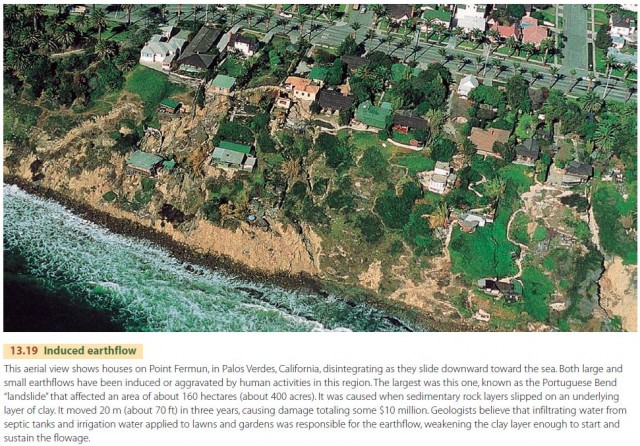
Explosives produce disruptive forces many times more powerful than the natural forces of physical weathering. Industrial societies now move great masses of regolith and bedrock from one place to another using this technology. We do this to extract mineral resources or to move earth when constructing highway grades, airfields, building foundations, dams, canals, and various other large structures. Both activities destroy the preexisting ecosystems and plant and animal habitats. When the removed materials are then used to build up new land on adjacent surfaces, they bury ecosystems and habitats.
Scarification is a general term for excavations and other land disturbances produced to extract mineral resources. Strip mining is a particularly destructive scarification activity, and Figure 13.20 describes the problems it can create. As a result, strip mining is under strict control in most locations. Nonetheless, scarification is on the increase, driven by an ever-increasing human population and a rising demand for coal and industrial minerals.
